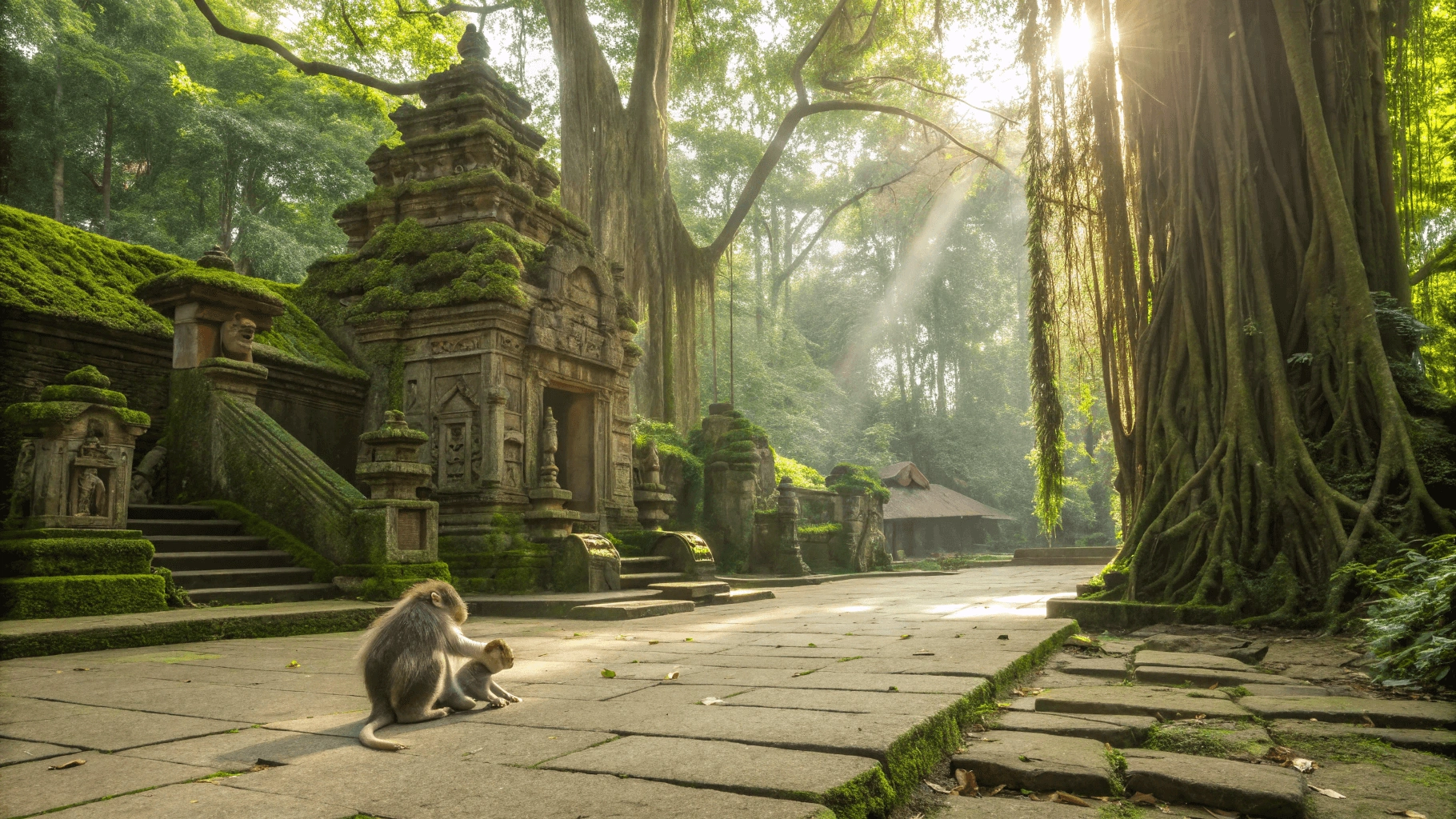Introduction
Step into a world where ancient temples stand shrouded in mist, massive banyan trees create a natural cathedral, and hundreds of playful monkeys swing freely through the canopy. The Sacred Monkey Forest in Ubud isn’t just another tourist attraction—it’s a magical realm where nature, wildlife, and Balinese spirituality intertwine to create one of the island’s most unforgettable experiences.
Located in the heart of Ubud, the cultural heart of Bali, this enchanting sanctuary (officially known as Mandala Suci Wenara Wana) offers visitors a rare opportunity to observe Balinese long-tailed macaques in their natural habitat while exploring lush forest grounds dotted with intricately carved stone temples that date back hundreds of years.
Whether you’re a wildlife enthusiast, a photography buff, or simply seeking a deeper connection with Balinese culture, the monkey forest bali indonesia provides a fascinating glimpse into the island’s unique harmony between people, nature, and spiritual traditions.
Table of Contents
| Quick Facts: Monkey Forest Bali Indonesia | |
|---|---|
| Location | Ubud, Bali, Indonesia |
| Official Name | Sacred Monkey Forest Sanctuary (Mandala Suci Wenara Wana) |
| Key Feature | Balinese long-tailed macaques & ancient temples |
| Opening Hours | 8:30 AM – 6:00 PM daily |
| Ticket Price | Adults: 80,000 IDR / Children (3-12): 60,000 IDR |
| Best For | Nature lovers, culture enthusiasts, photographers (with caution!) |
What Exactly IS the Sacred Monkey Forest Sanctuary?
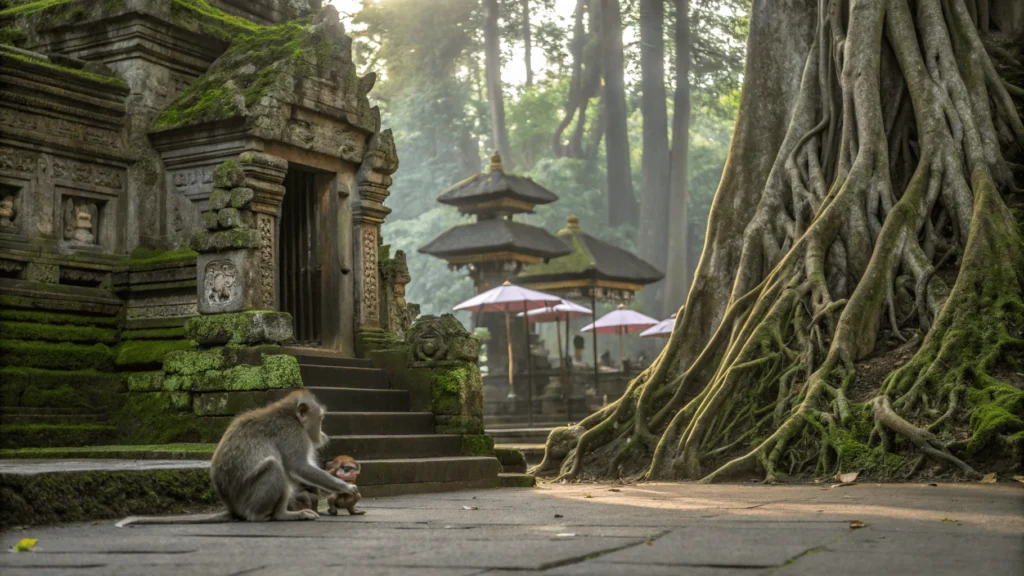
The Sacred Monkey Forest is far more than just a tourist attraction—it’s a vital multi-dimensional center for the village of Padangtegal and the surrounding community. This 12.5-hectare forest sanctuary serves four essential functions: “monkey forest bali indonesia”
- Spiritual Center: Home to three ancient Hindu temples dating back to the 14th century
- Economic Engine: Providing sustainable tourism employment for local residents
- Conservation Project: Preserving rare plants, animals, and ecosystem functions
- Educational Resource: Teaching visitors about Balinese culture and macaque behavior
At the spiritual heart of the sanctuary are three magnificent temples:
- Pura Dalem Agung (The Great Temple of Death): Dedicated to Lord Shiva, this imposing temple serves as a place to worship the god of death and transformation.
- Pura Beji (The Bathing Temple): Located near a refreshing spring, this temple is dedicated to the goddess Gangga and used for spiritual purification rituals.
- Pura Prajapati (The Funeral Temple): Associated with funeral rituals and ceremonies honoring the dead.
These temples remain active places of worship for the local Balinese, who often visit during religious ceremonies dressed in traditional attire.
The true stars of the forest, however, are the approximately 700+ Balinese long-tailed macaques (Macaca fascicularis) that call this sanctuary home. These highly intelligent primates live in well-organized social groups throughout the forest. The macaques are considered sacred guardians of the temples and are protected within the sanctuary boundaries. The forest population is divided into several distinct troops, each with its own territory and social hierarchy. “monkey forest bali indonesia”
Essential Planning: Tickets, Hours & Location (Updated April 2024)
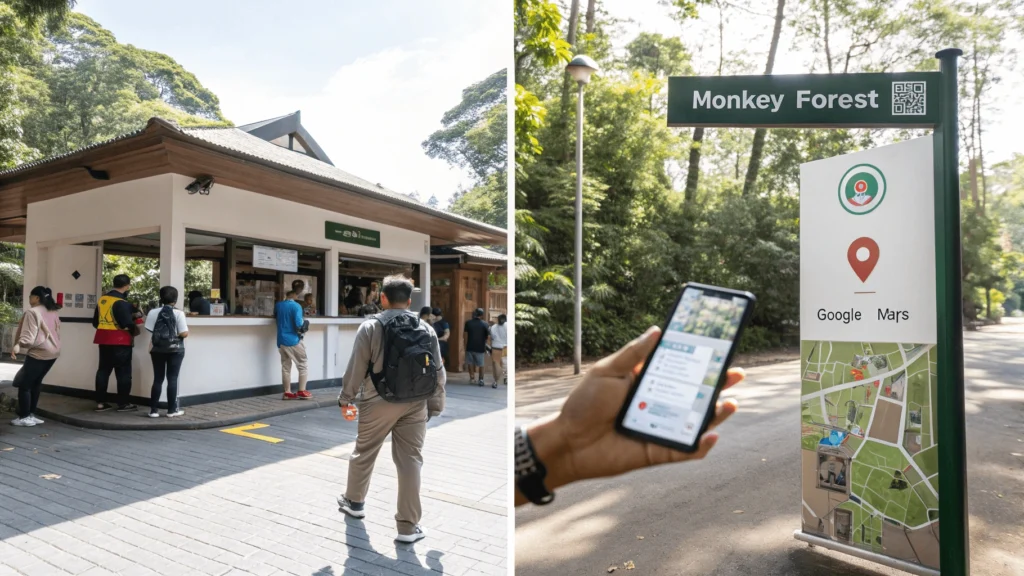
Current Opening Hours:
- Open daily from 8:30 AM – 6:00 PM
- Last entry at 5:30 PM
- No closures on public holidays
Ticket Prices & Where to Buy:
- Adult tickets: 80,000 IDR (approximately $5 USD)
- Child tickets (ages 3-12): 60,000 IDR (approximately $4 USD)
- Infants (under 3): Free
Tickets can be purchased at the main entrance ticket booths located on Monkey Forest Road. Both cash (IDR) and credit cards are accepted, though it’s always good to have cash on hand in case of technical issues. There is no official online booking system, so all tickets are purchased on-site upon arrival. “monkey forest bali indonesia”
Exact Location & How to Get There:
Address: Jl. Monkey Forest, Ubud, Kecamatan Ubud, Kabupaten Gianyar, Bali 80571, Indonesia
The Monkey Forest is conveniently located in southern Ubud, making it easily accessible by several means:
- Walking: If you’re staying in central Ubud, the forest is within easy walking distance (10-15 minutes) from most accommodations.
- Scooter: Rent a scooter (around 60,000-80,000 IDR per day) and park in the designated area near the entrance. Parking fee is approximately 5,000 IDR.
- Taxi/Ride-hailing: Both Grab and Gojek operate in Ubud (though sometimes with limitations). Ask to be dropped at the main entrance on monkey forest bali indonesia Road.
- Private Driver: Many hotels can arrange a private driver for the day, allowing you to combine your Monkey Forest visit with other Ubud attractions. “monkey forest bali indonesia”
Best Time to Visit:
Time of Day:
- Early Morning (8:30 AM – 10:00 AM): Ideal for avoiding crowds and enjoying cooler temperatures. The monkeys are often more active and playful in the morning after their night’s rest. This is also when they receive their first feeding of the day, making it an excellent time for observation.
- Midday (11:00 AM – 2:00 PM): The busiest and hottest time. The harsh midday sun makes photography challenging, and the monkeys are often less active, preferring to rest in shady spots.
- Late Afternoon (3:00 PM – 5:30 PM): As temperatures cool, both visitor numbers and monkey activity increase again. The golden hour light filtering through the forest canopy creates magical photo opportunities. “monkey forest bali indonesia”
Time of Year:
- Dry Season (April to October): Ideal for visiting with minimal chance of rain interrupting your exploration. The forest paths are less muddy and more easily navigable.
- Wet Season (November to March): Fewer tourists, but be prepared for sudden rain showers. The forest is at its most lush and vibrant during this time, with waterfalls and streams flowing more vigorously. To understand Bali’s wet and dry seasons in detail, refer to Indonesia’s official climate data via the BMKG (Meteorological, Climatological, and Geophysical Agency).
The Experience: What to Expect Inside the Monkey Forest
Stepping through the entrance gate, you’ll immediately notice the temperature drop as you enter the cool, verdant sanctuary. The cacophony of Ubud’s busy streets fades away, replaced by a symphony of natural sounds—rustling leaves, flowing water, distant monkey calls, and the occasional ceremonial music from nearby temples. “monkey forest bali indonesia”
Navigating the Paths
The forest features well-maintained stone pathways that wind through dense tropical vegetation. Moss-covered dragon statues and ancient stone carvings punctuate your journey, creating an atmosphere that feels both primal and sacred. The network of paths is well-marked and easy to follow, with several bridges spanning ravines and streams that cut through the forest floor.”monkey forest bali indonesia”
The terrain includes some stairs and modest inclines, but the paths are generally accessible for most visitors. The complete circuit through the forest, including stops to observe monkeys and view temple exteriors, typically takes 1-2 hours, depending on your pace and interest level. “monkey forest bali indonesia”
Observing the Monkeys
You won’t have to search hard to find the forest’s famous residents—the macaques are everywhere! Different troops control various sectors of the forest, and their behavior changes throughout the day:
- In the morning, witness grooming sessions as monkeys meticulously clean each other’s fur
- Watch youngsters play and chase each other across branches and stone statues
- Observe nursing mothers caring for tiny infants clinging to their bellies
- See the dominant males patrol their territory and settle disputes
Staff members in uniform are stationed throughout the sanctuary to ensure both visitor safety and monkey welfare. They’re extremely knowledgeable about macaque behavior and can often explain what you’re observing. “monkey forest bali indonesia”
Temple Areas
While the sanctuary’s three temples are central to its spiritual significance, access to their inner courtyards is generally restricted to worshippers during prayer times and ceremonies. Visitors can admire the ornate architecture and intricate stone carvings from designated viewing areas. “monkey forest bali indonesia”
The temples’ moss-covered walls, ancient statues, and ceremonial umbrellas create a mystical atmosphere that photographers will find irresistible. The blend of natural growth with human-made structures perfectly illustrates the Balinese philosophy of harmony between the natural and spiritual worlds. “monkey forest bali indonesia”
The Forest Itself
Beyond the monkeys and temples, the forest itself is a botanical wonder. Ancient banyan trees with aerial roots creating natural pillars, massive ferns, flowering plants, and rare medicinal herbs create a biodiverse ecosystem. Informational signs throughout the sanctuary identify many of these species and explain their traditional uses.
The constant sound of running water from streams and small waterfalls adds to the tranquil atmosphere, making the forest feel like a natural cathedral. Multiple clearings provide peaceful spots to rest and observe the surrounding nature. “monkey forest bali indonesia”
CRUCIAL: Monkey Forest Rules & Safety Tips (Do This, Not That!)
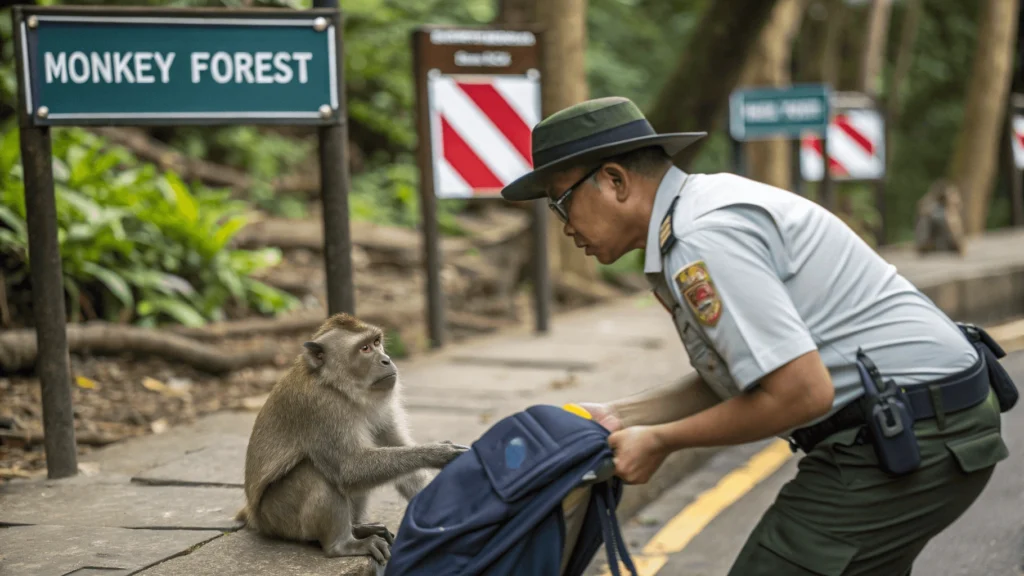
While the macaques may appear cute and friendly, it’s essential to remember they are wild animals with their own behaviors and boundaries. Following these guidelines will ensure both your safety and the welfare of the monkeys: “monkey forest bali indonesia”
DO:
- ✅ Secure all belongings in zipped bags or pockets
- ✅ Walk calmly and quietly through the forest
- ✅ Stay on designated paths at all times
- ✅ Keep valuables hidden (especially shiny objects)
- ✅ Remain aware of your surroundings
- ✅ Listen to staff instructions immediately
DON’T:
- ❌ Feed the monkeys (strictly forbidden and subject to fines!)
- ❌ Bring outside food or drinks (especially in plastic bags)
- ❌ Make direct eye contact with monkeys (they perceive it as aggression)
- ❌ Touch, pet, or attempt to hold the monkeys
- ❌ Run, shout, or make sudden movements
- ❌ Wear loose jewelry, dangling earrings, or hair accessories
What to Do if a Monkey Approaches or Jumps on You:
Despite your best precautions, monkeys may occasionally jump on visitors, especially if they suspect you have food or are carrying something interesting: “monkey forest bali indonesia”
- Stay calm and avoid panicking
- Don’t pull away suddenly or scream
- Avoid looking directly at the monkey
- If the monkey grabs something, let it go rather than engaging in a tug-of-war
- Slowly lower yourself if possible, making it easier for the monkey to jump off
- Ask for staff assistance if needed
Remember that staff members are trained to handle these situations and are always nearby to help.
Monkey Bites or Scratches:
Though rare when rules are followed, incidents can occur. The monkey forest bali indonesia has a first aid station near the main entrance for minor incidents. If you experience a bite or scratch: “monkey forest bali indonesia”
- Immediately notify sanctuary staff
- Clean the wound thoroughly with soap and water
- Visit the first aid station for initial treatment
- Seek professional medical attention as soon as possible for proper rabies prophylaxis
- Do not wait for symptoms to appear before seeking medical help
What to Wear:
- Comfortable walking shoes with good grip (paths can be slippery)
- Lightweight, breathable clothing appropriate for Bali’s warm climate
- Modest attire if you plan to visit other temples after the Monkey Forest
- A hat for sun protection in open areas
- No dangling accessories or loose scarves that might attract monkey attention
Photography Tips for the monkey forest bali indonesia
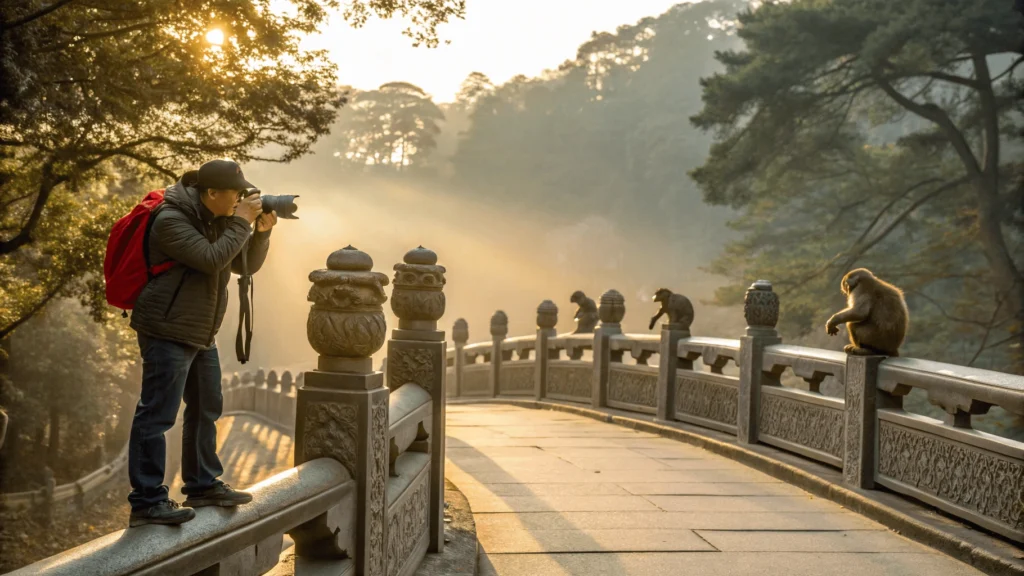
The Sacred Monkey Forest offers endless photographic opportunities, from capturing the playful antics of macaques to documenting the mystical temple architecture shrouded in mist and vegetation. “monkey forest bali indonesia”
Best Spots for Photos:
- The main Dragon Bridge with its moss-covered guardians
- Ancient banyan trees with massive aerial root systems
- Temple gateways (from permitted viewing areas)
- The “valley” area where monkeys often gather near a small stream
- The forest canopy from the elevated walkways
Equipment Recommendations:
- A zoom lens (70-200mm range) allows you to photograph monkeys from a safe distance
- Weather-sealed equipment is ideal for humid forest conditions
- Keep lens changes quick or in designated areas away from curious monkeys
- Consider a cross-body camera strap for security
- Bring lens cleaning supplies for misty conditions
Camera Settings:
- Fast shutter speeds (1/250 or faster) to freeze monkey movement
- Higher ISO settings to compensate for forest shade
- Wider apertures for subject isolation against busy backgrounds
- Burst mode for capturing unpredictable monkey antics
Respectful Photography Practices:
- Never use flash photography (it startles and disturbs the monkeys)
- Avoid blocking pathways while taking photos
- Keep a respectful distance from monkeys, especially mothers with babies
- Don’t position yourself between monkeys, which can make them feel trapped
- Ask permission before photographing local worshippers at temples
Beyond the Monkeys: Cultural Significance & Conservation

The Sacred Monkey Forest represents a perfect embodiment of the Balinese philosophical concept of Tri Hita Karana—the three causes of well-being and happiness. This holistic approach emphasizes harmony between: “monkey forest bali indonesia”
- Humans and God (Parahyangan): Represented by the three temples where spiritual connections are maintained
- Humans and Humans (Pawongan): Demonstrated through community management and economic opportunities
- Humans and Nature (Palemahan): Expressed through forest conservation and protection of the macaque population
The forest sanctuary is collectively owned by the village of Padangtegal, with revenue supporting not only forest maintenance but also community development projects, including infrastructure improvements, educational programs, and cultural preservation efforts. “monkey forest bali indonesia”
Conservation initiatives within the forest focus on:
- Protecting endangered plant species native to Balinese forests
- Maintaining sustainable monkey population levels
- Preserving the forest’s ecological functions as a green lung for Ubud
- Conducting ongoing research on macaque behavior and health
By visiting the monkey forest bali indonesia, you’re directly contributing to these conservation and community development efforts.
What’s Nearby? Combining Your Visit
The Sacred Monkey Forest’s central location makes it an ideal anchor for a full day of Ubud exploration. Consider combining your visit with these nearby attractions: “monkey forest bali indonesia”
Within Walking Distance:
- Ubud Palace (Puri Saren Agung): 15-minute walk north, showcasing traditional Balinese royal architecture
- Ubud Traditional Art Market: Directly across from the palace, offering handicrafts and souvenirs
- Campuhan Ridge Walk: 20-minute walk northwest, providing stunning valley views and a peaceful escape
- Yoga Barn: 15-minute walk northeast, offering classes throughout the day in a serene setting
Short Drive Required:
- Tegalalang Rice Terraces: 20-minute drive north, featuring Bali’s iconic stepped rice fields
- Goa Gajah (Elephant Cave): 15-minute drive east, an ancient meditation site with intricate carvings
- Pura Tirta Empul: 30-minute drive northeast, a water temple known for purification rituals
- Mas Village: 15-minute drive south, renowned for traditional wood carving
Dining Options:
- Habitat Café: Just minutes from the northern entrance, offering healthy options with forest views
- Kafe Bali: 10-minute walk north, serving vegetarian and vegan dishes
- Ibu Oka: 15-minute walk north, famous for traditional Balinese suckling pig
- Bebek Bengil: 5-minute walk east, known for crispy duck in a garden setting “monkey forest bali indonesia”
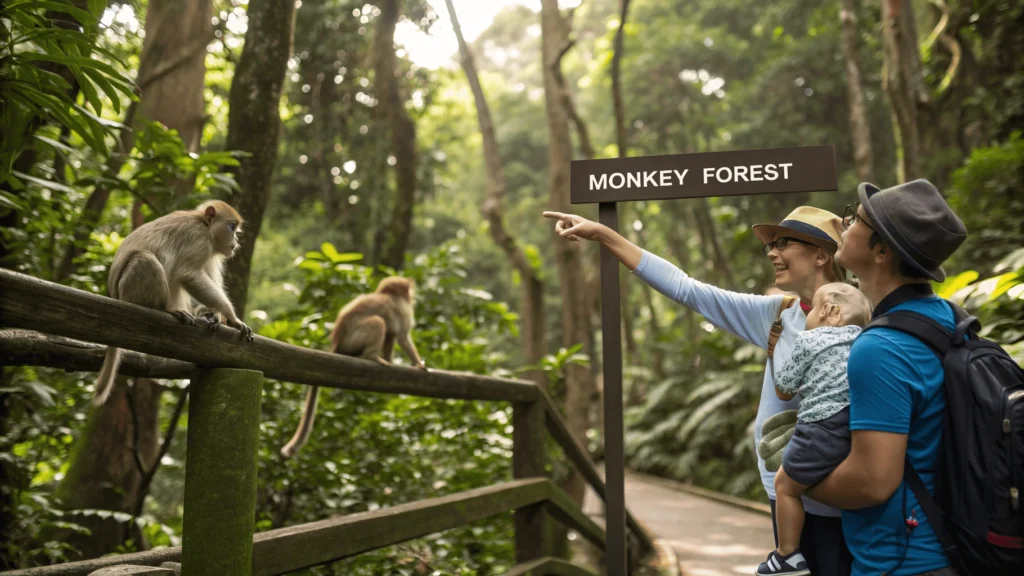
Frequently Asked Questions
Is the Monkey Forest Ubud worth visiting?
Absolutely! The Sacred Monkey Forest offers a unique blend of wildlife encounter, cultural immersion, and natural beauty that makes it one of Bali’s most memorable attractions. Even those initially hesitant about monkey interactions find the experience rewarding for the lush forest setting and temple architecture alone.
How long do you need at the Monkey Forest?
Most visitors spend between 1-2 hours exploring the forest, though photographers and nature enthusiasts might want to allow up to 3 hours. The pathways form a circuit that can be completed in under an hour, but taking time to observe monkey behavior, photograph temple details, and simply enjoy the peaceful atmosphere enhances the experience.
Are the monkeys dangerous in Ubud Monkey Forest?
The monkeys are wild animals with natural behaviors, not domesticated pets. When treated with respect and when safety guidelines are followed, the risk is minimal. Problems typically occur only when visitors ignore rules by attempting to feed, touch, or make direct eye contact with the macaques. Staff members throughout the sanctuary help ensure both visitor safety and monkey welfare.
Can you feed the monkeys in Bali Monkey Forest?
No. Feeding the monkeys is strictly prohibited and subject to fines. The sanctuary staff provides a balanced, nutritious diet for the macaque population at scheduled times. Visitor feeding disrupts their natural foraging behaviors, can cause nutritional problems, and encourages aggressive behavior.
What is the entrance fee for Ubud Monkey Forest?
As of April 2024, the entrance fee is 80,000 IDR (approximately $5 USD) for adults and 60,000 IDR (approximately $4 USD) for children aged 3-12. Children under 3 enter free. Prices are subject to change, so it’s always good to check the official website before visiting.
Can children visit the Monkey Forest?
Yes, children can visit the Monkey Forest, but parental supervision is essential. Keep young children close at all times and teach them the importance of calm behavior. Consider carrying smaller children in a front-facing carrier to prevent them from running or making sudden movements that might startle the monkeys. The forest pathways are generally stroller-friendly, though some areas have steps. “monkey forest bali indonesia”
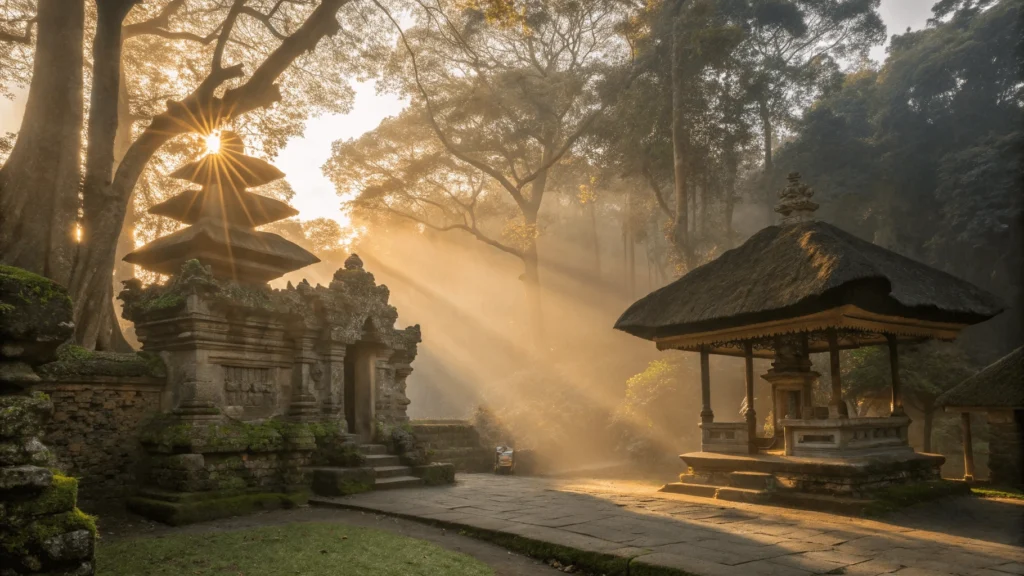
Conclusion “monkey forest bali indonesia”
The Sacred monkey forest bali indonesia Sanctuary in Ubud represents Bali at its most magical—a place where the boundaries between the natural and spiritual worlds seem to dissolve. As you walk beneath the ancient canopy, watching macaques swing through vine-draped trees while moss-covered temple guardians stand eternal watch, you’ll experience a profound connection to something much older and deeper than the typical tourist attraction.
Remember that the forest is not just a place for visitor entertainment but a sacred site that plays an integral role in Balinese spiritual life. By approaching your visit with respect, mindfulness, and proper preparation, you’ll not only ensure your own safety but also contribute to the preservation of this unique cultural treasure.
Have you visited the Sacred Monkey Forest in Ubud? What was your most memorable experience? Did you discover any tips that might help other travelers? We’d love to hear your stories and questions in the comments below!
Last updated: April 2024

